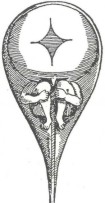Data and Theory Advance Science
Improvements in technology, communication of results, experiments designed to test specific hypotheses, careful observation, insightful interpretation all advanced our knowledge and understanding of our world and eliminated many inaccurate beliefs that arose out of ignorance and creative explanation.
 |
It was obvious to our ancestral observers that breeding of males and females resulted in offspring that were different from each parent but bore characteristics of each. Many thought that fluids from the two parents blended together to produce the children. When sperm were first observed after the invention of the microscope (1670s), people thought they saw a small man (the homunculus, or "little man") in the head of the sperm that was destined to be the new individual, and animalculists believed that the mother's role was only to provide a place for development of the future human being seen in the sperm. In the same decade, the ovary was described for the first time, and ovists believed the future human being was in the egg and the male fluid merely stimulated the egg to grow.
The hypothesis of blending inheritance, in which the hereditary material was mixed into a blend, did not match the results of breeders trying to develop new plant varieties. The hypothesis predicted that sexual reproduction would lead to blending that logically would result eventually in complete uniformity of characteristics. In contrast, parental characters reappeared in later generations, preserving the diversity among individuals. Gregor Mendel, through careful breeding experiments, deduced that there were units of inheritance that followed rules and persisted unchanged through the generations.
Quantum Mechanics
In the time of Isaac Newton (1642-1727), it was believed that light traveled in straight lines. Because of Newton's great reputation and authority, his theory that light consists of particles was accepted for more than a century. Then, in the 1800s, numerous experiments diffracted light and showed that it behaved as a wave. The classical wave theory of light culminated in 1860 when James Maxwell published his mathematical theory of electromagnetism, and concluded that light is an electromagnetic wave.
 |
Summary
In both these cases, scientists and others did their best to propose hypotheses that fit the observations and were consistent with their contemporary culture. As improvements in technology made it possible to gather additional evidence with accurate measurements, inconsistencies between the new data and the initial hypotheses led to better understanding of natural phenomena that opened the doors to further scientific progress. Strong loyalties to perceptions that the new details showed were inaccurate made it difficult for many non-scientists at that time to accept the new ideas that we now take for granted.
Excerpted and adapted from:
1. Curtis, H., and N. S. Barnes. 1989. Biology. Worth Publishers, Inc., NY
2. Tipler, Paul A., and Gene Mosca. 2008. Physics for Scientists and Engineers. W. H. Freeman and Company, NY. 6th Edition, p 1174-1177.